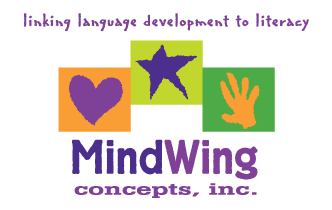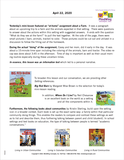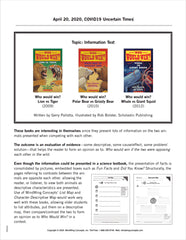Secure Checkout. FREE SHIPPING for Continental U.S. Orders over $60.
Menu
-
- Home
-
About Us
-
The Approach
-
Linking Language & Literacy
-
MindWing Learning
-
Learning Resources
-
SHOP
-
Blog
-
- About MindWing
- Our People
- Contact Us
- Your Account
- Login
-
United States (USD $)

Secure Checkout. FREE SHIPPING for Continental U.S. Orders over $60.

April 28, 2020: Book List for Older Students During COVID19, FB Live
April 28, 2020
Today, we talk about a list of books for older children. These books are great for teaching components of narrative development using our Story Grammar Marker® icons. If you and your students understand these components and can use them to focus the discussion of the story itself, they will be better at listening and reading comprehension. Each of the following lend themselves to a read-aloud, although each may be read traditionally. Also, each of the stories have some form of information, knowledge, used by the various authors. For instance, dePaola’s book begins with a hurricane; Fleischman’s concerns a garden: planting, sunlight, vegetables, etc...

April 24, 2020: Final Lesson Ideas for Settings, FB Live
April 24, 2020
Last of 3-Day Lesson Ideas for Settings: When choosing Big Red Barn as a follow-up to the “At the Farm” assigned passage, my purpose–as a parent at home–was to use the book to elaborate on the topic that was presented in the assigned passage, as a teacher may do in school. I wasn’t worried about lexiles. I wanted a book that would appeal to a child in kindergarten to read for fun and maybe to teach a few things. When looking through Big Red Barn I found many elaborations!

April 23, 2020: More On Settings, FB Live
April 23, 2020
Lesson Outcome: After completing this sequence, you will have expanded the initial lesson “At the Farm” provided for the student. Furthermore, you will have learned how to differentiate a lesson for children of different abilities. Also, you will have noticed that there are many levels within the activity: there will be some students who are able to tell a personal narrative readily. At the same time, there will be students who are at the stage of assembling the animals in order and putting them into the “barn.” Both children are learning the “personal narrative sequence” and will progress at their own pace...

April 22, 2020: More About Settings, FB Live
April 22, 2020
To broaden this lesson about settings and our conversation about a farm, we are providing other setting references: Big Red Barn by Margaret Wise Brown is the selection for today’s mini-lesson reading. Other suggestions are provided in the handout...

April 20, 2020: COVID19 Uncertain Times, FB Live
April 20, 2020
The “Who Would Win…” books are interesting in themselves since they present lots of information on the two animals presented when competing with each other. The outcome is an evaluation of evidence—some descriptive, some cause/effect, some problem/solution—that helps the reader to form an opinion as to: Who would win, it the two were opposing each other in the wild. Even though the information could be presented in a science text book, the presentation of facts is consolidated by pictures, embedded boxes such as Fun Facts and Did You Know? Structurally, the pages referring to contrasts between the animals are opposite each other, allowing the reader, or listener, to view both animals as descriptive...






